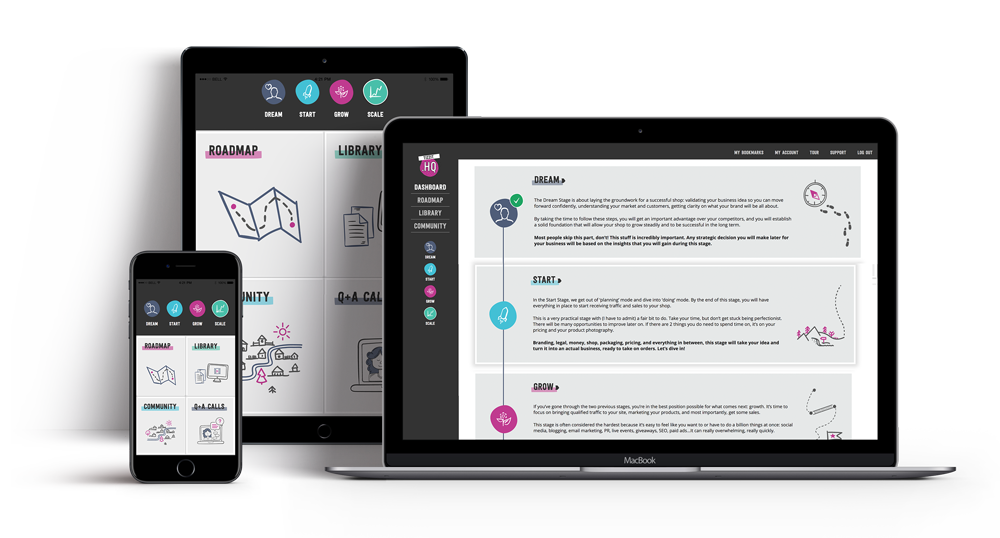from dream to handmade biz
Lesson 1 – mindset and productivity
lesson outline
- The ONE mindset change you need to make today.
- How to stay productive when life gets busy
- Time
- Space and equipment
- Goal setting and tracking
lesson resources
- This in depth article about how to plan your year, quarters, months, weeks, and days.
lesson checklist
- I am comfortable with the idea of charging for my products and know that making a profit is the single difference between a creative hobby and a successful shop.
- I will never underprice my work. My new favorite quote is “handmade doesn’t equal cheap”.
- I have considered the “practicalities” of starting a home based business (adequate workshop, adequate equipment, storage space, etc.) and I am ready to do this
- I have a system in place to keep myself organized, accountable and keep track of my progress (like the Maker’s Roadmap planner)
need more help?
check out tizzit hq

WHEN YOU BECOME A MEMBER, YOU GET ACCESS TO:
- The 4-stage Maker’s Roadmap system: an interactive, step-by-step guide to all the fundamental steps you need to take (and in what order!) to build a successful handmade shop
- 20+ in-depth courses and guest expert workshops (and more added monthly!)
Live Monthly Q&A Sessions - A friendly and supporting community of like-minded makers for you to connect with and get feedback from
- And so much more: accountability, quick wins videos and tutorials, workbooks and checklists, etc.
The ONE mindset change you need to make today
Being a successful handmade business owner comes down to one single mindset change that you need to make today. It’s the difference between crafting or making handmade goods for your own enjoyment, and running a profitable shop
That one thing? Money.
You have to be comfortable asking money for your products.
I know you might think that I am stating the obvious (“Duh Deb, thanks!”) but there is a big difference between knowing that profit is key, and actually being comfortable with it.
What do I mean? Let me explain.
The most common mistake that most handmade shop owners do is to underestimate the value of their time and of their skills and ultimately, underprice their products.
If you started making your products as a hobby, pricing your products can be frightening because you have no clue how much you should charge. You also forgot how valuable your skills are because well… you can make it! And you can’t remember how much your supplies cost because your craft room is full of stuff and seriously… who keeps track of that?
So you look online and try to align with the thousands shops on Etsy that will never make a profit themselves because they are underpricing their products too… BIG MISTAKE.
Look, I know it feels weird to charge for something that you made in the comfort of your home and that you used to make just for fun, but you have to be comfortable with asking for money for your work. You have to respect and value your work and your time.
You can’t try to compete on price or you will end up:
1 – broke
2 – exhausted
Not a good place to be in. Instead, I want you to remember every single day of your new entrepreneurial journey that:
Handmade does not equal cheap. That’s ‘Made in China’. Seriously, repeat it out loud as many time as you need: “handmade does not equal cheap!”
It’s ok to ask for money for your products. Don’t discount yourself or underprice your creations!
You don’t have a business until you make a profit. In the following lessons – when we get to pricing your products, accounting for your costs, and charging what you’re worth – take it seriously and do your homework.
How to stay productive when life gets busy
Whether you are trying to turn your hobby into a business on the side and already have another job that pays the bills (but that you can’t wait to quit!), whether you’re a full time mumma, or both (bless you if you are!)… life gets busy! Things gets in the way. And you are going to hit a few speed bumps. And that’s OK!
Starting and growing a business is not a sprint, it’s a marathon.
The best way to get to the finish line? Staying focused on what matters, being accountable, and going easy on yourself. Taking it one step at a time is key to avoid the overwhelm, and to grow your business long term.
When it comes to getting organized, keeping on track and making progress in your business consistently, there’s a few key elements you need to consider:
1 – Time
You might want to ask yourself: How many hours a week will I realistically be able to work on my business? It’s ok if it’s not much! Can you only work when baby takes a nap? That’s fine! It’s about being honest with yourself. Once you know, block that time on your calendar. You can always move it around and re-organize yourself from time to time, but if you don’t commit to taking time to do the work… Time will fly away! That’s what time does!
2 – Space and equipment
Where will you work from? Do you have a room at home you can use to make your products, keep your materials and supplies, and your shipping packages?
It isn’t a big deal if you don’t but it might be a good idea to make some room for it or your living room could soon enough look like a storehouse Finally, what type of equipment will you need in order to create your products? This could be anything from the need to update your sewing machine, to a new clay oven, to a better storage system for your yarns, etc.
3 – Goal setting and tracking
To move forward and grow your business in a meaningful way, you have to set goals and (that’s the most important part) you have to track your progress.
As a handmade business owner, you will have to wear two very different hats: the boss hat, and the worker hat. But it’s not always easy to know when to work for your business and when to work on your business. Let alone knowing what to focus on and how to keep track of what works and what doesn’t.
You probably just want to get to the meat of it right now, but trust me: taking the time to find a system that works for you and getting organized ( with an app like Trello, Asana, or even a simple notebook) will save you a lot of time down the road.
If you don’t know where to start, that’s perfectly fine. You can steal my system, based on what I called the “3×4=12” rule. Here’s the short version of how it works:
12 – Once a year, write down your objectives. This will take time, but it is crucial. Be as specific as possible. If one of your objectives is to increase your sales, note by how much? If you want to grow your email list: How many subscribers do you want to reach by the end of this 12-month period?
3×4: Every 3 months (so 4 times per year) look at your 12-month goals and ask yourself: What do I need to do in the next 3 months to get closer? This quarterly assessment allow you to stay focused on your yearly goals, while making room for experimentation.
Once you have your 3-month plan (based on your 12-month plan), break down your objectives into small, actionable tasks organized by priority, and focus on doing!
Before moving on to Lesson 2, don’t forget to complete this lesson’s checklist!
